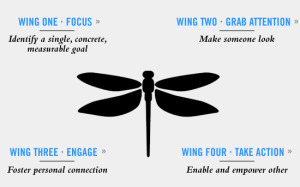 Last week I went to an event about Open Innovation in Public Services at The British Library.
Last week I went to an event about Open Innovation in Public Services at The British Library.
Open innovation involves collaboration with partners and networks to share the risk and reward of developing new ideas. It is an innovation model that is used in the corporate sector and there are an increasing number of public and third sector organisations starting to ‘do’ open innovation.
It’s a good idea, as Bill Joy, co-founder of Sun Microsystems said “Because not all the smart people work for you”
We heard from five speakers
Vicky Purewal Head of Challenge Prize Design at Nesta spoke about her work to grow the field of challenge prizes.
A challenge prize offers a reward to whoever can first or most effectively meet a defined challenge. The challenge prize concept dates back hundreds of years; canned food was a solution to a problem back in 1795 when the French military offered a cash prize of 12,000 francs for a new method to preserve food.
Challenge prizes as a way to solve problems has seen big growth in recent decades. The challenge prize model is effective in seeking ideas from a wide audience, it is more flexible than grant funding for an idea or project as there are less strings attached and the concept of winning a prize is filled with excitement as opposed to obtaining a more sobering ‘grant’ type of funding.
The design of the challenge prize and process, including the setting of clear goals and context is crucial to the prizes success. Check out some examples of challenge prizes run by Nesta, the NHS and the X Prize Foundation.
Carl Reynolds, (introduced as a Doctor and a geek), spoke about NHS Hack days.
A hack day is a gathering of a diverse group of people for at least a whole day (sometimes more) to work on a specific problem. There is an element of competition, prizes and a commitment to develop the solutions once the day is over. Hacks originated from software developers so usually involve a technology solution.
Carl’s had identified that the poor use of IT was making NHS staff jobs harder and their work less efficient, so the focus of the hack day was to ‘make NHS IT less bad’.
Given that they were starting from a fairly low benchmark, getting some key people together for a hack day to address this challenge was seen to be achievable at a relatively low-cost and risk. After all what could be a worse outcome than the current situation? Things could only improve.
The NHS hack days involve doctors, patients, healthcare experts, technology and software developers and designers. The first one was in May 2012. 120 people attended over two days, eight judges selected the best ideas and there was one overall winner. There was a range of solutions that you can see here.
Heather Niven from GeniUS York spoke about the open process they have piloted to solve the City of Yorks strategic and operational challenges.
In response to massive public sector cuts York Council identified that they could not continue to deliver their services using their current business model.
They developed an open innovation pilot giving staff and local people the opportunity get involved in solving some of the challenges in their local communities. They developed an ideas platform in a record quick time of 3 days. They launched challenges on the platform for a short time period and involved an online community of staff and the public to suggest solutions.
This pilot has repositioned innovation as a priority and turned York Council from a ‘big tanker to flotilla of active networked organisations and individuals’.
Heather spoke about what they had learned; the need to go at a slightly slower pace, the value of getting input from outside of the organisation, how brave senior managers had to be to open up and the shift in culture required to help staff to get involved. Heather’s ultimate tip for anyone setting something like this up is ‘be brave and proceed until apprehended’
Jenny Parkin from Camden Council spoke about their Innovation and Development Fund
The Innovation and Development Fund is designed to engage with residents and staff to facilitate and build capacity for innovation in the borough of Camden and help communities make things happen in their local area.
The funds criteria is for ideas that address socially engrained problems in new and different ways, ideas that positively change current practice and demonstrate financial sustainability in a way that is new to the Council.
Asking the outside world to come and help deliver services is a cultural shift and the approach to the fund has been an iterative one of learning and making changes at each funding round. Jenny shared some of the learning about the importance of communicating the opportunity to a range of audiences and the making the process as simple as possible. Jenny highlighted the value of the shift in culture and approach required and the learning journey the Council had been on as much as the end results.
David Townson spoke about the Design Councils’ leadership programme that supports public sector clients to improve products and services.
David spoke of the importance of design as a framework for innovation and how all innovation should originate from an understanding of your audiences and the challenges they face. The real innovation is how you help them solve those challenges.
Getting closer to your audience or customers helps you gain insights that you would not get just sat behind your desk. David spoke about sending Barking and Dagenham Council teams on ‘service safaris’ and forcing people to go to where their customers were and experience what they experienced to gather real information. Following service safaris teams visualised, sketched and prototyped their ideas.
At the end of the process the teams have a sketchbook of ideas and have engaged with their customers, providing insight and a better understanding of the problems that their communities face. Only when you have an understanding of the real problems your customers are facing are you in a position to solve them.
Open innovation is now part of the Barking and Dagenham training programme, creating a cultural shift, a different approach to problem solving and more importantly providing more effective services.
How do I start doing Open Innovation?
There are many ways to develop open innovation to help your organisation develop better products and services. If you are considering this there are five key tips to consider.
- Be clear on your end goal.
- Build good relationships, seek to understand your audiences, whether staff, customers or the public
- Communicate clearly at every stage, keep people in the conversation, listen and respond to feedback
- Be open about what is working and what is not and learn from it
- Just start. You won’t have all the answers and that is exactly the point. The value of open innovation is finding solutions with others.
How could your organisation use an open innovation model to develop better fundraising and services through challenge prizes, hack days or an open innovation programme?









